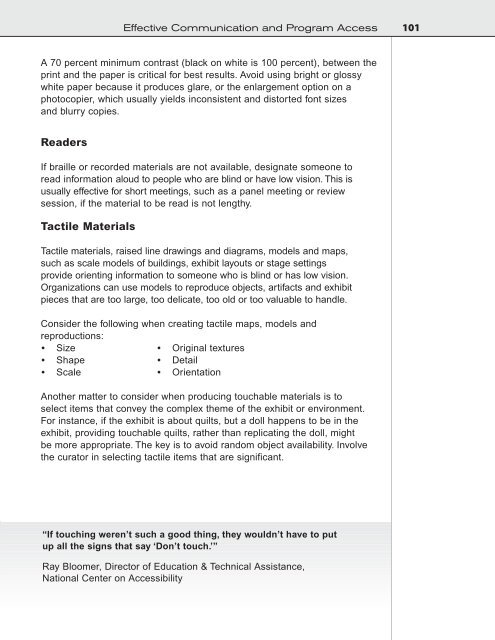Design for Accessibility: A Cultural Administrator's Handbook
Design for Accessibility: A Cultural Administrator's Handbook
Design for Accessibility: A Cultural Administrator's Handbook
You also want an ePaper? Increase the reach of your titles
YUMPU automatically turns print PDFs into web optimized ePapers that Google loves.
Effective Communication and Program Access 101<br />
A 70 percent minimum contrast (black on white is 100 percent), between the<br />
print and the paper is critical <strong>for</strong> best results. Avoid using bright or glossy<br />
white paper because it produces glare, or the enlargement option on a<br />
photocopier, which usually yields inconsistent and distorted font sizes<br />
and blurry copies.<br />
Readers<br />
If braille or recorded materials are not available, designate someone to<br />
read in<strong>for</strong>mation aloud to people who are blind or have low vision. This is<br />
usually effective <strong>for</strong> short meetings, such as a panel meeting or review<br />
session, if the material to be read is not lengthy.<br />
Tactile Materials<br />
Tactile materials, raised line drawings and diagrams, models and maps,<br />
such as scale models of buildings, exhibit layouts or stage settings<br />
provide orienting in<strong>for</strong>mation to someone who is blind or has low vision.<br />
Organizations can use models to reproduce objects, artifacts and exhibit<br />
pieces that are too large, too delicate, too old or too valuable to handle.<br />
Consider the following when creating tactile maps, models and<br />
reproductions:<br />
• Size • Original textures<br />
• Shape • Detail<br />
• Scale • Orientation<br />
Another matter to consider when producing touchable materials is to<br />
select items that convey the complex theme of the exhibit or environment.<br />
For instance, if the exhibit is about quilts, but a doll happens to be in the<br />
exhibit, providing touchable quilts, rather than replicating the doll, might<br />
be more appropriate. The key is to avoid random object availability. Involve<br />
the curator in selecting tactile items that are significant.<br />
“If touching weren’t such a good thing, they wouldn’t have to put<br />
up all the signs that say ‘Don’t touch.’”<br />
Ray Bloomer, Director of Education & Technical Assistance,<br />
National Center on <strong>Accessibility</strong>


